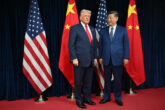October 12, 2015
China's Military Capabilities in 2020: Implications for the U.S. and Regional Partners
On October 10 CNAS hosted a roundtable discussion as a part of its Alliance Roadmap Series. The event, “China’s Military Capabilities in 2020: Implications for the U.S. and Regional Partners,” featured Dr. Roger Cliff, Brigadier-General Kum Wah Leong, and Dr. Narushige Michishita helping lead a discussion of the People’s Liberation Army and its evolving abilities. Dr. Cliff’s new book, China’s Military Power: Accessing Current and Future Capabilities, played a crucial organizing role.
Discussants opened by recognizing that the PLA was definitely getting more attention in recent months, from parades to testing prominent weapon systems to annual double-digit percentile increases in spending. Military power was more than hardware and budget numbers, it was widely agreed, as intangibles like doctrine, culture, and training have consistently proven to be much more decisive.
Following this theme, experts in the group outlined how the gap between U.S. and PLA capabilities was indeed narrowing in certain ways. Today’s PLA has cultivated a domestic defense industry capable of producing modern weapons systems, has an incoming stream of better-educated and more urban recruits, and is seeing substantial improvements in its logistics, structural, and training regimens. Discussants explored expected structural changes, including certain command authorities being pushed “down” to more localized control, support organizations being moved under the umbrella of the otherwise-ephemeral Ministry of Defense, and troops beginning a rotation-based assignment process rather than career-long placements. Even so, the capabilities the PLA has improved are still mismatched to its doctrine of maneuver and indirect engagement. Such a doctrine would require a widespread culture of risk taking, initiative, and an organic organizational structure—all aspects the PLA decidedly still lacks.
Yet while the PLA’s doctrine is still poorly realized, discussants agreed it is by no means a paper tiger. Geographic advantages could combine with its areas of improvement to make a hypothetical conflict in the Asia-Pacific region very costly for the United States. When discussing the case of an invasion of Taiwan, participants agreed that the Chinese would likely be unable to successfully take the island in the face of an American response. Even so, the PLA’s capabilities have advanced such that it would be much more painful for the U.S. to repulse them than it used to be—bringing into question whether the U.S. had the political will to absorb such pain.
Even assuming that the PLA’s improvements would continue apace into the future, participants agreed that there was no replacement for combat experience. Such experience reveals holes in planning and highlights cracks in logistics. As the PLA begins consolidating some of its command structure, it may soon find that planes used to receiving maintenance at one airfield will find needed parts missing at their new airfields. Similarly, adopting modern career paths that require rotations at different locales could have adverse effects on readiness as morale and family concerns impede training and education.
Yet even with all the PLA’s challenges, China and is still seen ascendent thanks to both its economic and military growth. Logistics or structural constraints are certainly limiting, but are not inherently permanent, discussants agreed. Further, despite the PLA’s doctrine/capabilities mismatch and tightly bounded realm of operations, China is still successfully inducing anxiety on the part of the U.S. and its allies in the region. The U.S. still operates a superior force, but as the previously-unquestioned nature of its military dominance becomes increasingly eroded, the region is likely to see a period of tension and uncertainty.
More from CNAS
-
North Korea Reveals Troop Dispatch to Russia amid U.S.-South Korea Policy Talks
North Korea has confirmed for the first time that its troops are operating in Russia, and it is preparing to rewrite its party charter with the possibility of officially namin...
By Dr. Go Myong-Hyun
-
Chinese Maker of Bitcoin-Mining Machines Is a Security Threat, Says Expert
Bloomberg News reports that a Chinese manufacturer, Bitmain Technologies Ltd, that sells most of the world’s Bitcoin-mining machines — including 16,000 of them to a venture ba...
By David Feith
-
Indo-Pacific Security / Energy, Economics & Security
North Korea’s Provocations, Power Plays, and Shifting AlliancesTensions on the Korean Peninsula have reached a new and dangerous threshold. President Lee Jae Myung is warning of a real risk of accidental military clashes, as the situation...
By Dr. Go Myong-Hyun
-
Indo-Pacific Security / Energy, Economics & Security
How to Win the Economic War with ChinaTrump's approach to China has run aground, giving Beijing unprecedented advantage in the economic conflict....
By Edward Fishman & Julian Gewirtz



